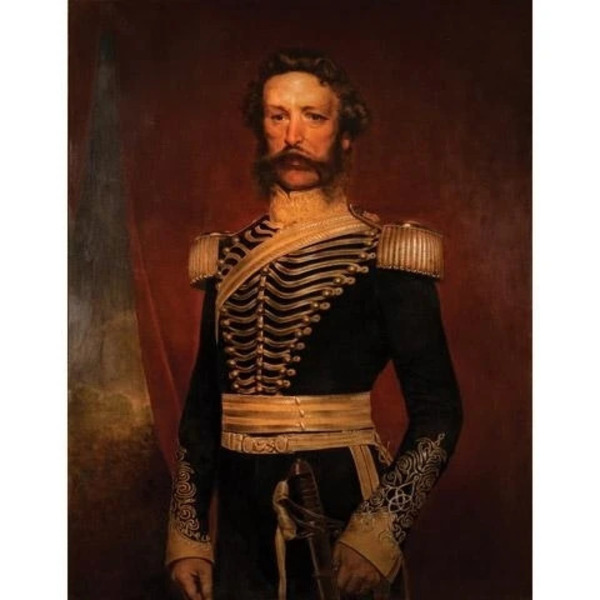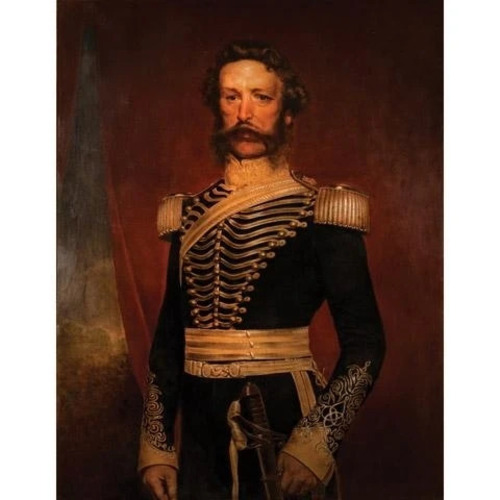
Source: Link
DENISON, GEORGE TAYLOR (sometimes designated as George T. Denison Jr, George T. Denison II, or George T. Denison of Rusholme, to avoid confusion with his father and eldest son), lawyer, landowner, farmer, and militia officer; b. 17 July 1816 at York (Toronto), U.C., second son of George Taylor Denison and Esther Borden Lippincott, loyalist; m. Mary Anne Dewson of West Gwillimbury Township and had nine children, the eldest being George Taylor Denison* of Heydon Villa; d. 30 May 1873 at Toronto, Ont., and was buried with military honours in the family’s private cemetery, St John’s-on-the-Humber, Weston, Ont.
George Taylor Denison’s grandfather, John, was among the first inhabitants of York. He established the family’s position as minor landed gentry, a status that was enhanced by his son G. T. Denison of Bellevue who, at his death in 1853, was reputedly the wealthiest private landholder in Canada West. G. T. Denison I also secured the family’s place among Tories influential in Toronto affairs. A vigorous proponent of the loyalist ideal of creating a British nation in North America, he had used his wealth and position to promote the growth of the volunteer militia as a necessary adjunct of Tory social and political leadership and as Upper Canada’s first line of defence against both external and internal threats. In 1822 he created the York Dragoons, one of the first cavalry troops attached to the York militia.
George Taylor Denison of Rusholme was cast in the mould established by his father and grandfather. After receiving his formal education at Upper Canada College, he articled under George Cartwright Strachan, son of John Strachan*, and was admitted to the bar of Upper Canada in 1839. He was actively engaged in legal practice only until 1856, however, having amassed extensive landholdings which required all his energies. Rusholme, his estate in west Toronto, was itself a farm where Denison raised field crops and tobacco for export, cattle, swine, and thoroughbred horses. Surrounding Rusholme were the farms of Denison’s tenants whose rents were partially commuted into labour on the estate. In addition, Denison leased land from the city of Toronto for development as residential sites, and as Toronto spread westward to the edge of his estates he subdivided much of his land into fashionable “park lots.” These and other commercial ventures (such as contracts for the resurfacing of Toronto’s major thoroughfares) provided Denison with a fortune of almost $200,000 at middle age, and an income permitting him to accept the heavy social, political, and military responsibilities that were assumed by his family.
Denison represented Saint Patrick’s ward as alderman from 1843 until 1853 when he led seven other councillors in resigning over the admitted complicity of Toronto’s mayor, John G. Bowes*, in Francis Hincks*’ “£10,000 job,” which involved many public officials who profited privately from the Northern Railway scheme. A member of the Toronto Turf Club, Denison was among those men responsible for establishing the “Queen’s Plate” racing classic. He was also a founder of the Upper Canadian (later Dominion) Rifle Association in 1861 and was an officer of the St George’s Society. In every respect Denison was characteristic of the generation of vigorous young businessmen whose enthusiasm propelled Toronto into commercial and cultural rivalry with Montreal.
But it was Denison’s commitment to his family’s adopted function as soldiers dedicated to the survival of the loyalist ideal in North America that led to his most lasting contribution. First gazetted as an officer in the 1st Regiment of West York militia in 1834, Denison joined his father’s cavalry troop in 1838. He rose to the rank of full colonel and commandant of the 5th and 10th military districts in 1860, and at his death was the senior militia officer in Ontario. He saw action at the battle of Gallows Hill in 1837 when William Lyon Mackenzie*’s rebels were routed, and was later attached to Sir Allan MacNab*’s force which pursued the insurgents in the London area and which laid siege to Navy Island in the Niagara River. During the Fenian invasions of 1866 Denison was in command of the Toronto garrison.
His main contribution, however, was his activity on behalf of an indigenous Canadian military establishment during the critical period of responsible government in Canada when the institutions of nationhood were being forged. A viable native defensive force was one of the prerequisites of self-determination in British North America after 1846. Nevertheless, successive governments in the Province of Canada, especially during the troubled years between 1854 and 1866, consistently refused to provide adequately for local defence in spite of the dangers of open Anglo-American hostilities. The militia was in a state of stagnation, offset partially by the volunteers who maintained themselves in readiness. George Denison and his brothers Richard Lippincott and Robert Brittain set an early precedent in 1839 when the disbandment of the active force threatened the demise of the Queen’s Light Dragoons (an honorary designation conferred on the York Dragoons during the campaigns of 1837–39); their equipment was to be returned to imperial stores. The Denisons purchased all of the necessary equipment themselves, renamed the troop “Denison’s Horse,” and continued to drill the men. When the Militia Act of 1846 failed to provide funds for the maintenance of troops of volunteer cavalry, considered by the Denisons to be the crucial element in local defence strategy, George Denison of Rusholme, now commanding officer of Denison’s Horse, regazetted the troop as the 1st Toronto Independent Troop of Cavalry (it became the York Light Dragoons in 1853 and was designated the Governor-General’s Body Guard in 1866) and thereafter maintained it out of his private fortune. In 1853 he also organized the first field battery to be integrated with the Mounted Force of the York militia (9th Field Battery), and he reorganized several independent infantry companies to create the 2nd battalion, Queen’s Own Rifles. Meanwhile, Denison and his son, George Taylor, campaigned by pamphlet, letter, and personal pressure on senior officials and officers to promote more vigorous policies in support of the militia as the mainstay of provincial and, ultimately, national defence.
It is impossible to assess with accuracy the impact of Denison’s individual effort, but it is clear that, with others like him, he aided the development of a Canadian military tradition, especially the volunteering spirit, through difficult and trying times.
G. T. Denison II was the author of “The burning of the Caroline,” Canadian Monthly and National Review (Toronto), III (1873), 289–92; Chronicle of St. John’s Cemetery on the Humber (Toronto, 1868).
MTCL, Denison family papers. PAC, MG 29, F13 (George Taylor Denison III papers); RG 7, G12, 74; RG 9, I, C1, 291, 292. PAO, ms 58, Percy C. Band collection (microfilm copy). F. C. Denison, Historical record of the Governor-General’s Body Guard and its standing orders (Toronto, 1876). G. T. Denison III, The national defences; or, observations on the best defensive force for Canada (Toronto, 1861); Soldiering in Canada (Toronto, 1900). Globe (Toronto), 31 May 1873. Leader (Toronto), 31 May 1873. Chadwick, Ontarian families, I, 108–10. E. J. Chambers, The Governor-General’s Body Guard: a history of the origin, development and services of the senior cavalry regiment in the militia service of the Dominion of Canada (Toronto, 1902). R. L. Denison, The Canadian pioneer Denison family of county York, England and county York, Ontario (4v., Toronto, [c.1951–c.1953]), IV. Scadding, Toronto of old (Armstrong). C. P. Stacey, Canada and the British Army, 1846–1871 (2nd ed., Toronto, 1963). G. F. G. Stanley, Canada’s soldiers: the military history of an unmilitary people (Toronto, 1960). Samuel Thompson, Reminiscences of a Canadian pioneer for the last fifty years; an autobiography (Toronto, 1884). C. F. Hamilton, “Defence, 1812–1912,” Canada and its provinces (Shortt and Doughty), VII, 379–468.
Cite This Article
David Gagan, “DENISON, GEORGE TAYLOR (George T. Denison Jr, George T. Denison II, George T. Denison of Rusholme) (1816-73),” in Dictionary of Canadian Biography, vol. 10, University of Toronto/Université Laval, 2003–, accessed April 30, 2025, https://www.biographi.ca/en/bio/denison_george_taylor_1816_73_10E.html.
The citation above shows the format for footnotes and endnotes according to the Chicago manual of style (16th edition). Information to be used in other citation formats:
| Permalink: | https://www.biographi.ca/en/bio/denison_george_taylor_1816_73_10E.html |
| Author of Article: | David Gagan |
| Title of Article: | DENISON, GEORGE TAYLOR (George T. Denison Jr, George T. Denison II, George T. Denison of Rusholme) (1816-73) |
| Publication Name: | Dictionary of Canadian Biography, vol. 10 |
| Publisher: | University of Toronto/Université Laval |
| Year of revision: | 1972 |
| Access Date: | April 30, 2025 |



